Current Bishops of the Archdiocese of Atlanta
Past Bishops of Atlanta
“We Are The Lord’s”
Archbishop Gregory was named the sixth archbishop of the Archdiocese of Atlanta in December 2004 and installed in January 2005.
- Grown to approximately 1.2 million Catholics
- Established 12 parishes and 7 missions
- Ordained 71 priests and 172 permanent deacons
- Over 150,000 infants and minors Baptisms
- Over 130,000 First Communions
- Over 70,000 Confirmations
- Over 23,000 Marriages
- Over 25,000 Adult Baptisms and Receptions into the church
- Expanded the Office of Intercultural Ministries and the outreach to the Archdiocese of Atlanta’s growing diverse Catholic community.
- Led and participated in numerous local and national Ecumenical and Inter-religious initiatives to improve our world as faith communities.
Archbishop Gregory has served in many leading roles in the U.S. church. In November 2001, he was elected president of the U.S. Conference of Catholic Bishops following three years as vice president under Bishop Joseph Fiorenza of the Diocese of Galveston-Houston.
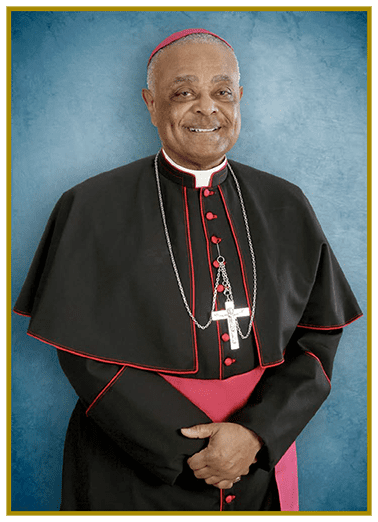
During his tenure in office, the crisis of sex abuse by Catholic clergy escalated; and under his leadership, the bishops implemented the “Charter for the Protection of Children and Young People.”
With an earned doctorate in sacred liturgy and nine honorary degrees, Archbishop Gregory has written extensively on church issues, including pastoral statements on the death penalty, euthanasia/physician-assisted suicide and has published numerous articles on the subject of liturgy, particularly in the African-American community.
In 2006, Archbishop Gregory joined an illustrious group of preachers with his induction into the Martin Luther King, Jr. Board of Preachers at Morehouse College, Atlanta. At the National Pastoral Life Center in Washington, D.C., Archbishop Gregory was honored with the Cardinal Bernardin Award given by the Catholic Common Ground Initiative (2006).
Archbishop Gregory served North Georgia faithfully until his Installation as Archbishop of the Archdiocese of Washington on May 21, 2019.
Archbishop Gregory’s Coat of Arms
The impalement of the personal Arms of Archbishop Gregory with those of the Archdiocese of Atlanta was undertaken by Deacon Paul Sullivan of Saunderstown, Rhode Island. The Arms of the Archdiocese of Atlanta were devised by the late William F. J. Ryan, New York, NY, and West Chatham, MA.
Written by: Rev. Mr. Paul J. Sullivan, Permanent Deacon of the Diocese of Providence
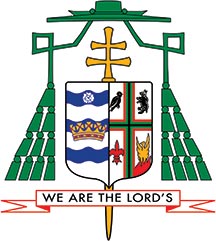
Blazon
Arms impaled. Dexter: Bary wavy of seven Argent and Azure; at the centre point overall an open crown Or and at the honour point a rose of the first with a center of the last. Sinister: Argent, on a cross Gules a cross Sable fimbriated Vert; between to chief dexter a raven Proper, to chief sinister a bear rampant of the third, to base dexter a fleur-de-lis of the second and to base sinister a phoenix Or issuant from flames of the second.
Significance
The archiepiscopal heraldic achievement or archbishop’s coat of arms is composed of a shield with its charges (symbols), a motto scroll and the external ornamentation. The shield, which is the central and most important feature of any heraldic device, is described (blazoned) in 12th century terms that are archaic to our modern language, and this description is presented if given by the bearer with the shield being worn on the arm. Thus, where it applies, the terms dexter and sinister are reversed as the device is viewed from the front.
By heraldic tradition the arms of the bishop, who is “first among equals” of an ecclesiastical province, called a “Metropolitan Archbishop,” are joined, impaled, with the arms of his jurisdiction. In this case, these are the arms of the Archdiocese of Atlanta.
These arms are composed of a field that is composed of seven alternating silver (white) and blue bars charged with a silver and gold rose and a gold crown.
For years, known as the “Crossroads of the South,” because it served as the hub of transportation in the region, Atlanta was originally known as “ Whitehall .” A succession of names, “Terminus,” in 1843 “Marthasville”, finally came to be “ Atlanta,” indirectly referencing the Atlantic Ocean, signified by the wavy bars of the design, in 1847. Upon this symbolism are an open gold crown to honor the titular of the Cathedral Church , Christ the King and a Cherokee Rose (Rosa Laevigata), a white rose with a golden center, the state flower of Georgia.
For his personal arms, His Excellency, Archbishop Gregory has retained the design that was adopted upon his selection to receive the fullness of Christ’s Priesthood, as a bishop, when he was appointed as an Auxiliary Bishop for the Archdiocese of Chicago and he retained the design during his tenure as Bishop of Belleville.
On a silver (white) field is a cross, of The Faith, that is composed of three colors; black on green on red. These colors are referred to as the African-American colors and by their use, His Excellency, Archbishop Gregory honors the religious and racial heritage that has come to him from his parents, Wilton and Ethel (Duncan) Gregory.
Within the quarters that are formed by the cross are a raven, to honor the Archbishop’s Benedictine education at Sant’ Anselmo (in Rome), and a black bear taken from the arms of His Eminence, Joseph Cardinal Bernardin, His Excellency’s principal Episcopal consecrator. Also within the quarters are a red fleur-de-lis taken from the arms of the Mundelein Seminary in Chicago, where Archbishop Gregory was a student and faculty member, and a golden phoenix, coming forth from red flames, to honor Chicago, the city reborn after the famous Chicago fire.
For his motto, Archbishop Gregory continues to use the phrase “We are the Lord’s,” which is taken from St. Paul ’s Epistle to the Romans (Romans 14:8). By the use of this phrase, His Excellency, Archbishop Gregory expresses the deep Christian belief that all that we are and in all that we do, “we are the Lord’s.”
The achievement is completed with the external ornaments which are a gold processional cross that has two cross-members, that is placed in back of and which extends above and below the shield, and the pontifical hat, called the “gallero,” with its ten tassels, in four rows, on either side of the shield, all in green. These are the heraldic insignia of a prelate of the rank of archbishop by instruction of The Holy See of March 31, 1969.
“God is Love”
Bishop Luis R. Zarama was ordained to the Roman Catholic Priesthood for the Archdiocese of Atlanta on November 27, 1993. His first assignment was as parochial vicar at Sacred Heart of Jesus Catholic Church in Atlanta. Bishop Zarama was the first Hispanic priest to be named pastor in the Archdiocese of Atlanta to St. Mark Catholic Church in Clarksville, GA and St. Helena Mission in Clayton, GA. He was later named Vicar General of the Archdiocese in April 2006. About a year later, he was named Chaplain of His Holiness with the title of monsignor by Pope Benedict XVI. On September 29, 2009, he was ordained as Titular Bishop of Bararus and Auxiliary Bishop of the Archdiocese of Atlanta. He served in this role for 8 years.

Auxiliary Bishop Luis R. Zarama’s Coat of Arms
The impalement of the personal Arms of Bishop Zarama with those of the Archdiocese of Atlanta was undertaken by Deacon Paul Sullivan of Saunderstown, Rhode Island.
Blazon: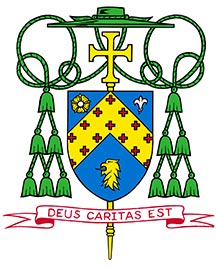
Azure, upon a chevron of double width Or a semé of crosses Gules; to chief dexter a rose of the second and to sinister a lily Agent; in base a lion’s hear couped of the second.
Significance:
The episcopal heraldic achievement or bishop’s coat of arms is composed of a shield with its charges (symbols), a motto scroll and the external ornamentation. The shield, which is the central and most important feature of any heraldic device, is described (blazoned) in 12th century terms, that are archaic to our modern language, and this description is presented as if given by the bearer with the shield being worn on the arm. Thus, where it applies, the terms dexter and sinister are reversed as the device is viewed from the front.
For his personal arms, His Excellency, Bishop Zarama has adopted a design to reflect his life and ministry as a priest.
On a blue field is displayed an extra wide chevron of Gold (yellow). This device gives the illusion of two mountains; a gold one and a blue one. The gold mountain (the chevron) is charged with a scattering (semé) of red crosses to represent the Bishop’s home city of Pasto, in southwestern Colombia, which is known as “The Theological City.” The lower mountain (part of the blue field) has a golden lion’s head to represent the Evangelist, Saint Mark, who is the titular patron of the parish in Clarkesville, Georgia, on a mountain, where Bishop Zarama served as pastor.
Above the chevron are a gold rose Saint Theresa of the Child Jesus, also known as “The Little Flower,” and a silver (white) lily for Saint Joseph, the Foster Father of Jesus, who have served as Bishop Zarama’s particular patron throughout his life as a priest and now as a bishop.
His Excellency, Bishop Zarama has selected for his motto the Latin phrase “DEUS CARITAS EST.” This phrase “GOD IS LOVE” is the title of an encyclical by His Holiness, Pope Benedict XVI, and it sums up in a succinct statement all that the Church and Christianity are to be all about . . . sharing the love of God.
The achievement is completed with the external ornaments which are a gold episcopal processional cross, that is placed in back of and which extends above and below the shield, and the pontifical hat, called a “gallero,” with its six tassels, in three rows, on either side of the shield, all in green. These are the heraldic insignia of a prelate of the rank of bishop by instruction of The Holy See of March 31, 1969.
by: Deacon Paul J. Sullivan
“He Will Give you A New Heart”
Bishop David P. Talley was ordained a priest in the Archdiocese of Atlanta on June 3, 1989. He served at many parishes, and was a member of many advisory boards and departments throughout the archdiocese. On December 12, 2012, he was named Auxiliary Bishop of the Archdiocese of Atlanta, where he served for nearly three years.

Auxiliary Bishop David Prescott Talley’s Coat of Arms
The impalement of the personal Arms of Bishop Talley with those of the Archdiocese of Atlanta was undertaken by Deacon Paul Sullivan of Saunderstown, Rhode Island.
Blazon: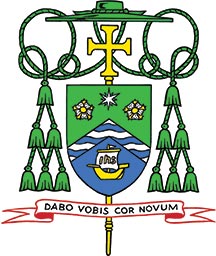
Party per chevron Vert and Azure; the chevron bary wavy Argent and of the second; to chief a “Stella Maris” of the third between two “Cherokee Roses” Proper; the bark of St. Peter Or, the sail of the third charged with the monogram of the Holy Name Gules.
Significance:
The episcopal heraldic achievement, or bishop’s coat of arms, is composed of a shield, which is the central and most important part of the design, a scroll with a motto and the external ornamentation. The design is described (blazoned) as if the description was being given by the bearer (from behind) with the shield being worn on the left arm. Thus, it must be remembered, where it applies, as the device is viewed from the front that the terms sinister and dexter are reversed.
As a bishop without canonical jurisdiction (an auxiliary bishop), Bishop Talley’s personal arms occupy the entire shield of the design.
His Excellency, Bishop Talley’s arms are composed of several major and significant aspects. Prime among these is the special twelve-pointed silver (white) star known as the “Stellar Maris,” or “Star of the Sea,” a classic symbol honoring Our Blessed Mother, to whom His Excellency has such deep and profound devotion. The Stella Maris is placed between two “Cherokee Roses,” silver (white) petals and gold (yellow) barbs and seed, that are the state flower of Georgia and are displayed in the arms of the Diocese of Savannah, where Bishop Talley was born, in Columbus, and in the arms of the Archdiocese of Atlanta where His Excellency has been called to serve as Auxiliary Bishop.
The chevron, from the Prescott family arms is composed of Silver (white) and blue wavy bars, representing water and it signifies the Chattahoochee and the Savannah rivers that run throughout the territories of the two Georgia dioceses.
In the base of the design, is the bark of St. Peter, gold (yellow) with a silver (white) sail charged with the IHS, the monogram of the Holy Name, in red. The bark is the central feature of the logotype of the “Year of Faith” as designated by Pope Benedict XVI; the year of the New Evangelization now being carried forward by a new Holy Father, Pope Francis.
For his motto, His Excellency Bishop Talley has selected the Latin phrase “DABO VOBIS COR NOVUM.” The phrase, taken from the Book of Ezekiel (Ez. 36:26) expresses His Excellency’s faith that Jesus Christ instructs us that He “Will Give You a New Heart.”
The achievement is completed by the external ornamentation which are a gold (yellow) processional cross, that is placed in back of the shield and which extends above and below the shield, and the pontifical hat, called a “galero,” with its six tassels in three rows on either side of the shield, all in green. These are the heraldic insignia of a prelate of the rank of bishop, by instruction of The Holy See, of March 31, 1969.
by: Deacon Paul J. Sullivan
Archbishop John F. Donoghue
“To Live in Christ Jesus”
Archbishop Donoghue was named as the fifth Archbishop of the Archdiocese of Atlanta in 1993. When he was appointed to Atlanta, Archbishop Donoghue made the center of his pastoral work among Catholics to renew understanding of and devotion to the Eucharist as the real presence of Christ. He served North Georgia faithfully until his retirement on December 9, 2004. On November 11, 2011, Archbishop-Emeritus John F. Donoghue passed away at the age of 83.
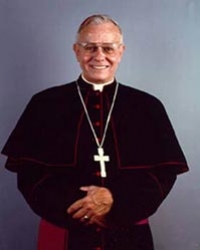
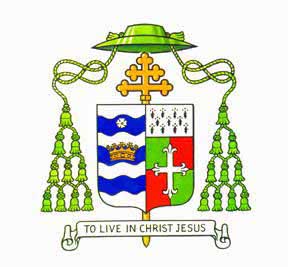 The entire “achievement,” or coat of arms as it is generally called, is composed of the shield with its charges, the motto and the external ornaments. As one looks at the shield the terms dexter (right) and sinister (left) must be understood contrariwise, as the shield was worn on the arm in medieval days and these terms were used in the relationship of the one bearing the shield.
The entire “achievement,” or coat of arms as it is generally called, is composed of the shield with its charges, the motto and the external ornaments. As one looks at the shield the terms dexter (right) and sinister (left) must be understood contrariwise, as the shield was worn on the arm in medieval days and these terms were used in the relationship of the one bearing the shield.
The dexter impalement is given in ecclesiastical heraldry to the arms of jurisdiction; in this instance, the arms of the Archdiocese of Atlanta.
Atlanta known as the “Crossroads of the South,” because of converging railroads which gave the city its early prominence, received its name as the eastern terminus of the Western and Atlantic Railroad which connected north Georgia with the Tennessee River. Originally called Whitehall, then Terminus, and afterwards in 1843 Marthasville, the state legislature finally acquiesced to the wishes of the railroad and accepted the name of Atlanta in 1847, thus naming the city indirectly after the Atlantic Ocean.
The Atlantic Ocean is represented on the shield of the archdiocese by white and blue wavy bars, the heraldic equivalent of the waves of the sea; seven bars in number to symbolize the Seven Sacraments.
The crown of Christ the King denotes the title of the cathedral church, the Eternal King whose redeeming Sacrifice on the Cross is renewed daily in the Holy Sacrifice of the Mass. Above the crown is placed the Cherokee rose, the State flower of Georgia (Rosa Laevigata), as befits an archdiocese located in the Capital City. The Cherokee rose is a white flower with a yellow center.
The crown of Christ the King, in the arms of the Archdiocese of Atlanta, also has the secondary representation of the crown of King George II of England after whom Georgia was named. The blue and white wavy bands may be said as well to symbolize the rolling foothills of the Blue Ridge country; but, more important, these are the colors of our Blessed Mother.
The sinister impalement, on the right of the viewer, bears the personal arms of Archbishop Donoghue. These consist of a field, or surface quartered green and red. The quartering is found in the arms of the Archdiocese of Washington, and commemorates Archbishop Donoghue’s priestly ministry in that archdiocese. The green and red are the surface colors of the arms of the Irish septs of O’Donoghue and Ryan, and honor the Archbishop’s paternal and maternal ancestry.
The central charge of the arms is a silver (white) cross with its limbs terminating in a fleur-de-lis. This cross flory honors Archbishop Donoghue’s baptismal patron, Saint John Vianney (1786-1859). The fleur-de-lis has long been a symbol of the Blessed Virgin Mary, and here joined to the cross, alludes to the Archbishop’s Pauline motto and his devotion to Christ’s Mother. The chief portion of the shield is ermine (white and black ermine tails) and commemorates Archbishop Donoghue’s long association with Patrick Cardinal O’Boyle, second archbishop of Washington, whose arms bore an ermine chief.
The motto, “To Live in Christ Jesus,” has been adapted from Saint Paul’s Epistle to the Philippians 1:21.
In pale behind the arms is placed a gold archiepiscopal cross with a double transverse. A pontifical hat with ten tassels on each side disposed in four rows, all green, surrounds the shield ensigning the whole achievement.
Prior to 1870, the pontifical hat was worn in solemn conclaves held in conjunction with papal functions. The color of the pontifical hat and the number and color of the tassels were signs of the rank of a prelate, a custom which is still preserved in ecclesiastical heraldry.
Archbishop James P. Lyke O.F.M.
“Christus Pax”
On June 24, 1991, the Most Reverend James P. Lyke was installed as the fourth Archbishop of Atlanta. Archbishop Lyke grew up in Chicago and was a convert to Catholicism. He served as Auxiliary Bishop of Cleveland from 1979-1990. At the time of his death from cancer on December 27, 1992, Archbishop Lyke was the highest-ranking African-American clergyman in the United States.
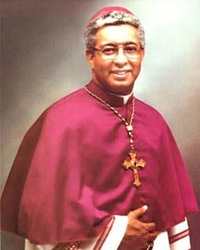
 The entire “achievement,” or coat of arms as it is generally called, is composed of the shield with its charges, the motto and the external ornaments. As one looks at the shield the terms dexter (right) and sinister (left) must be understood contrariwise, as the shield was worn on the arm in medieval days and these terms were used in the relationship of the one bearing the shield.
The entire “achievement,” or coat of arms as it is generally called, is composed of the shield with its charges, the motto and the external ornaments. As one looks at the shield the terms dexter (right) and sinister (left) must be understood contrariwise, as the shield was worn on the arm in medieval days and these terms were used in the relationship of the one bearing the shield.
The dexter impalement is given in ecclesiastical heraldry to the arms of jurisdiction; in this instance, the arms of the Archdiocese of Atlanta.
Atlanta known as the “Crossroads of the South,” because of converging railroads which gave the city its early prominence, received its name as the eastern terminus of the Western and Atlantic Railroad which connected north Georgia with the Tennessee River. Originally called Whitehall, then Terminus, and afterwards in 1843 Marthasville, the state legislature finally acquiesced to the wishes of the railroad and accepted the name of Atlanta in 1847, thus naming the city indirectly after the Atlantic Ocean.
The Atlantic Ocean is represented on the shield of the archdiocese by white and blue wavy bars, the heraldic equivalent of the waves of the sea; seven bars in number to symbolize the Seven Sacraments.
The crown of Christ the King denotes the title of the cathedral church, the Eternal King whose redeeming Sacrifice on the Cross is renewed daily in the Holy Sacrifice of the Mass. Above the crown is placed the Cherokee rose, the State flower of Georgia (Rosa Laevigata), as befits an archdiocese located in the Capital City. The Cherokee rose is a white flower with a yellow center.
The crown of Christ the King, in the arms of the Archdiocese of Atlanta, also has the secondary representation of the crown of King George II of England after whom Georgia was named. The blue and white wavy bands may be said as well to symbolize the rolling foothills of the Blue Ridge country; but, more important, these are the colors of our Blessed Mother.
The sinister impalement, on the right of the viewer, bears the personal arms of Archbishop Lyke. These consist of a quartered shield on the lower two-thirds of the sinister in black and green with a gold cross. Superimposed on this is a narrower red cross. The colors red, black and green are significant to black Americans because they were used by the United Negro Improvement Association and African Communities League. They are dominant in the flags of many African nations. Red symbolizes redemption, blood and liberty; black is for the black people and green stands for hope.
The quartered shield with the gold cross recalls the mystery of the Church and honors Pope John Paul II from whose coat of arms it is derived. The narrower cross imposed on the gold cross is red, the academic color for theology and conveys Archbishop Lyke’s special interest in same.
In the first quadrant of the quartered shield is a white chaplet of the Franciscan cord to emphasize Archbishop Lyke’s devotion to Saint Francis of Assisi and the Franciscan ideal.
The upper portion of the shield displays the arms of the Friars Minor. The field is silver (white) with a black Latin cross above two crossed arms. One arm wears a Franciscan robe representing Saint Francis. It is pierced, recalling that the saint was a stigmatic. The other arm with pierced hand represents the crucified Christ.
The Latin motto “Christus Pax,” translates as “Christ Our Peace,” and is taken from Saint Paul’s epistle to the Ephesians, chapter 2, verses 13 and 14. The motto further emphasizes the cross of Christ which reconciles our differences and unites all in faith.
Behind the arms is placed a gold archiepiscopal cross with double traverse. Surrounding the shield or “achievement,” is a pontifical hat with ten tassels on each side in four rows, all in green
Prior to 1870, the pontifical hat was worn in solemn conclaves held in conjunction with papal functions. The color of the pontifical hat and the number and color of the tassels were signs of the rank of a prelate, a custom which is still preserved in ecclesiastical heraldry.
Archbishop Eugene A. Marino S.S.J.
Archbishop Eugene A. Marino was installed as the third Archbishop of Atlanta on May 5, 1988. He was the first African-American to be named Archbishop in the United States. On July 10, 1990 Archbishop Marino resigned his position. He died in New York on November 12, 2000.
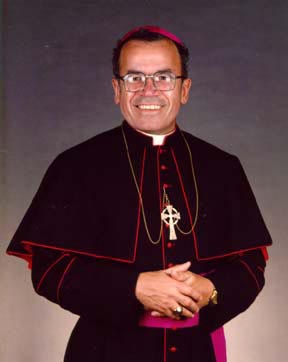
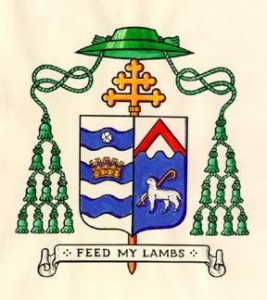 The entire “achievement,” or coat of arms as it is generally called, is composed of the shield with its charges, the motto and the external ornaments. As one looks at the shield the terms dexter (right) and sinister (left) must be understood contrariwise, as the shield was worn on the arm in medieval days and these terms were used in the relationship of the one bearing the shield.
The entire “achievement,” or coat of arms as it is generally called, is composed of the shield with its charges, the motto and the external ornaments. As one looks at the shield the terms dexter (right) and sinister (left) must be understood contrariwise, as the shield was worn on the arm in medieval days and these terms were used in the relationship of the one bearing the shield.
The dexter impalement is given in ecclesiastical heraldry to the arms of jurisdiction; in this instance, the arms of the Archdiocese of Atlanta.
Atlanta known as the “Crossroads of the South,” because of converging railroads which gave the city its early prominence, received its name as the eastern terminus of the Western and Atlantic Railroad which connected north Georgia with the Tennessee River. Originally called Whitehall, then Terminus, and afterwards in 1843 Marthasville, the state legislature finally acquiesced to the wishes of the railroad and accepted the name of Atlanta in 1847, thus naming the city indirectly after the Atlantic Ocean.
The Atlantic Ocean is represented on the shield of the archdiocese by white and blue wavy bars, the heraldic equivalent of the waves of the sea; seven bars in number to symbolize the Seven Sacraments.
The crown of Christ the King denotes the title of the cathedral church, the Eternal King whose redeeming Sacrifice on the Cross is renewed daily in the Holy Sacrifice of the Mass. Above the crown is placed the Cherokee rose, the State flower of Georgia (Rosa Laevigata), as befits an archdiocese located in the Capital City. The Cherokee rose is a white flower with a yellow center.
The crown of Christ the King, in the arms of the Archdiocese of Atlanta, also has the secondary representation of the crown of King George II of England after whom Georgia was named. The blue and white wavy bands may be said as well to symbolize the rolling foothills of the Blue Ridge country; but, more important, these are the colors of our Blessed Mother.
The sinister impalement, on the right of the viewer, bears the personal arms of Archbishop Marino. These consist of a blue shield with a lamb in a walking position supporting with its right foreleg a gold pastoral staff. The chief or upper portion of the shield is silver with a wavy line separating the upper and lower portions. A red chevron is superimposed on the upper portion.
The lamb has an honored and ancient history in Christian art as a symbol of Christ and the Eucharist as well as being the object of the shepherd’s care.
In this instance, the lamb is supporting a pastoral staff by which Archbishop Marino wishes to emphasize the strength which comes from the unity of the pastor with those committed to his care. The lamb recalls the words of Christ to Simon Peter: “Feed my lambs,” as recorded by John the Evangelist in his Gospel chapter 21, verse 15, and selected by Archbishop Marino as his episcopal motto. The lamb also recalls the archbishop’s paternal heritage for it is the chief element on the Great Seal of the Commonwealth of Puerto Rico.
The wavy chief, upper portion, symbolic of water, both scripturally and sacramentally recalls the necessity of washing, cleansing and giving of life to those who would live in Christ. It also represents the archbishop’s native state of Mississippi, “The Father of Waters,” and acknowledges his maternal heritage and birthplace.
It is an established custom in ecclesiastical heraldry for members of religious orders who are raised to the episcopate to display the arms of their community, or part of it, in their episcopal arms. In keeping with this custom, the archbishop, a member of the Society of Saint Joseph and the Sacred Heart (Jospehites), selected the carpenter’s square as a chevron from the arms of the community. It is tinctured red in honor of the Sacred Heart.
The blue field of the archbishop’s shield honors the Blessed Virgin Mary. It also is found in the arms of the Josephite community.
Behind the arms is placed a gold archiepiscopal cross with double traverse. Surrounding the shield or “achievement,” is a pontifical hat with ten tassels on each side in four rows, all in green.
Prior to 1870, the pontifical hat was worn in solemn conclaves held in conjunction with papal functions. The color of the pontifical hat and the number and color of the tassels were signs of the rank of a prelate, a custom which is still preserved in ecclesiastical heraldry.
Archbishop Thomas A. Donnellan was appointed the second Archbishop of Atlanta on May 24, 1968 and was installed on July 16, 1968. Archbishop Donnellan, 54 years old at the time, was a native of New York City. Prior to his Atlanta appointment he had served four years as Bishop of Ogdensburg, New York.
The population of the Atlanta Archdiocese tripled during his 19 years as Archbishop and the number of Catholics grew from 50,000 in 1968 to 175,000. Thirty-two parishes were established during this time. Archbishop Donnellan suffered a stroke on May 1, 1987 and died on October 15, 1987.

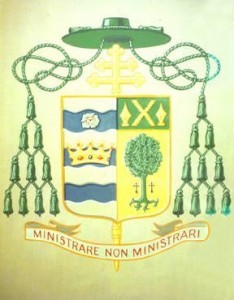 The entire “achievement,” or coat of arms as it is generally called, is composed of the shield with its charges, the motto and the external ornaments. As one looks at the shield the terms dexter (right) and sinister (left) must be understood contrariwise, as the shield was worn on the arm in medieval days and these terms were used in the relationship of the one bearing the shield.
The entire “achievement,” or coat of arms as it is generally called, is composed of the shield with its charges, the motto and the external ornaments. As one looks at the shield the terms dexter (right) and sinister (left) must be understood contrariwise, as the shield was worn on the arm in medieval days and these terms were used in the relationship of the one bearing the shield.
The dexter impalement is given in ecclesiastical heraldry to the arms of jurisdiction; in this instance, the arms of the Archdiocese of Atlanta.
Atlanta known as the “Crossroads of the South,” because of converging railroads which gave the city its early prominence, received its name as the eastern terminus of the Western and Atlantic Railroad which connected north Georgia with the Tennessee River. Originally called Whitehall, then Terminus, and afterwards in 1843 Marthasville, the state legislature finally acquiesced to the wishes of the railroad and accepted the name of Atlanta in 1847, thus naming the city indirectly after the Atlantic Ocean.
The Atlantic Ocean is represented on the shield of the archdiocese by white and blue wavy bars, the heraldic equivalent of the waves of the sea; seven bars in number to symbolize the Seven Sacraments.
The crown of Christ the King denotes the title of the cathedral church, the Eternal King whose redeeming Sacrifice on the Cross is renewed daily in the Holy Sacrifice of the Mass. Above the crown is placed the Cherokee rose, the State flower of Georgia (Rosa Laevigata), as befits an archdiocese located in the Capital City. The Cherokee rose is a white flower with a yellow center.
The crown of Christ the King, in the arms of the Archdiocese of Atlanta, also has the secondary representation of the crown of King George II of England after whom Georgia was named. The blue and white wavy bands may be said as well to symbolize the rolling foothills of the Blue Ridge country; but, more important, these are the colors of our Blessed Mother.
The sinister impalement, on the right of the viewer, bears the personal arms of Archbishop Donnellan.
The oak tree from the coat of arms of the Donnellan family of Galway, the ancestors of the Archbishop, has been emblazoned on the personal arms, but the field has been changed from silver to gold that the Irish colors might prevail to pay homage to Saint Patrick, the title of the Cathedral of the Archdiocese of New York, where Archbishop Donnellan spent the early years of his priesthood.
The ermine spots at either side are derived from the coat of arms of Francis Cardinal Spellman, the late Cardinal-Archbishop of New York, by whom Archbishop Donnellan was ordained a priest and consecrated a bishop.
The chief (upper portion) is given to two spearheads at either side of a saltire. The spearheads recall that the archbishop’s baptismal patron, Saint Thomas was martyred by these instruments. The saltire is the well-known symbol of Saint Andrew, the Apostle, whose name the Archbishop also bears. Saint Andrew, the brother of Saint Peter, is believed to have been martyred upon a cross in the shape of the letter X.
The motto, “Ministrare non Ministrari,” is translated “To serve, not to be served.” The full text of the scriptural verse from which the motto is derived reads: “… even as the Son of Man has not come to be served but to serve, and to give his life for the ransom for many.” (Matthew 20:28). A motto expresses briefly an ideal, a plan of life and the spirit of the one who selects it.
The external ornaments are composed of the pontifical hat, with its tassels, disposed in four rows, all in green, and the archiepiscopal cross with double transverse tinctured in gold. These are the trappings of a prelate of the rank of archbishop.
Prior to 1870, the pontifical hat was worn in solemn conclaves held in conjunction with papal functions. The color of the pontifical hat and the number and color of the tassels were signs of the rank of a prelate, a custom which is still preserved in ecclesiastical heraldry.
Auxiliary Bishop (Mar 9, 1966 to Apr 5,1968)
On February 21, 1962 the Diocese of Atlanta was elevated to the status of Archdiocese. Paul J. Hallinan, Bishop of Charleston, S.C. was named the first Archbishop of Atlanta.
Born in Painesville, Ohio, April 8, 1911, he was ordained to the priesthood in Cleveland in 1937 and served as an army chaplain in the South Pacific during World War II. He was installed as Archbishop of Atlanta on March 29, 1962. Archbishop Hallinan is best remembered for his personal dedication to the cause of social justice and his involvement in the civil rights activity of the 1960’s. He was also deeply involved in the renewal of the Catholic Church, especially in the area of worship, during and following the Second Vatican Council. On March 27, 1968 Archbishop Hallinan died after a long battle with hepatitis.
During the last two years of his life, Archbishop Hallinan was assisted by Auxiliary Bishop Joseph L. Bernardin, who eventually became Cardinal-Archbishop of Chicago.
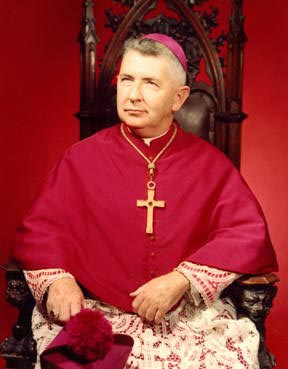
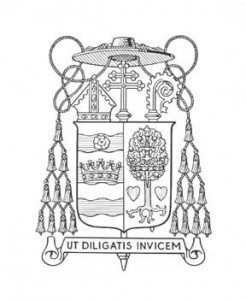 The entire “achievement,” or coat of arms as it is generally called, is composed of the shield with its charges, the motto and the external ornaments. As one looks at the shield the terms Dexter (right) and sinister (left) must be understood contrariwise, as the shield was worn on the arm in medieval days and these terms were used in the relationship of the one bearing the shield.
The entire “achievement,” or coat of arms as it is generally called, is composed of the shield with its charges, the motto and the external ornaments. As one looks at the shield the terms Dexter (right) and sinister (left) must be understood contrariwise, as the shield was worn on the arm in medieval days and these terms were used in the relationship of the one bearing the shield.
The dexter impalement is given in ecclesiastical heraldry to the arms of jurisdiction; in this instance, the arms of the Archdiocese of Atlanta.
Atlanta known as the “Crossroads of the South,” because of converging railroads which gave the city its early prominence, received its name as the eastern terminus of the Western and Atlantic Railroad which connected north Georgia with the Tennessee River. Originally called Whitehall, then Terminus, and afterwards in 1843 Marthasville, the state legislature finally acquiesced to the wishes of the railroad and accepted the name of Atlanta in 1847, thus naming the city indirectly after the Atlantic Ocean.
The Atlantic Ocean is represented on the shield of the archdiocese by white and blue wavy bars, the heraldic equivalent of the waves of the sea; seven bars in number to symbolize the Seven Sacraments.
The crown of Christ the King denotes the title of the cathedral church, the Eternal King whose redeeming Sacrifice on the Cross is renewed daily in the Holy Sacrifice of the Mass. Above the crown is placed the Cherokee rose, the State flower of Georgia (Rosa Laevigata), as befits an archdiocese located in the Capital City. The Cherokee rose is a white flower with a yellow center.
The crown of Christ the King, in the arms of the Archdiocese of Atlanta, also has the secondary representation of the crown of King George II of England after whom Georgia was named. The blue and white wavy bands may be said as well to symbolize the rolling foothills of the Blue Ridge country; but, more important, these are the colors of our Blessed Mother.
The sinister impalement, on the right of the viewer, bears the personal arms of Archbishop Hallinan.
The arms of the Irish Hallinan family consist of a silver field emblazoned with a green oak tree, its roots exposed, and bearing a golden crown in the middle of the foliage. These arms have been “differenced” by the addition of a golden sword to honor Saint Paul, the baptismal patron of the archbishop, and by two red hearts, from the coat of arms of the revered Cardinal Newman, to honor the titular of the Newman Foundation of Western Reserve University, where the archbishop served as chaplain at the time of his elevation to the episcopacy.
The tree of the Hallinan arms has more than a passing interest inasmuch as the grandfather and father of the archbishop were both nurserymen.
O’Hallinan is derived from the Gaelic “Hailgheanain,” variously spelled O’Hallinaine, O’Hallinan, Hallinan, Hallanan and Halnan, who are descendants of “Ailgheanan,” the diminutive of “Ailghean,” meaning “noble offspring.” It is an old Munster surname found chiefly in Cork and Limerick counties.
The motto, “Ut Diligatis Invicem” is translated “That you love one another.” The full text of this verse from the Gospel of Saint John reads: “This is my commandment, that you love one another as I have loved you” (15:12), a part of the discourse of Our Lord to the apostles at the Last Supper.
Behind the arms is placed a gold archiepiscopal cross with double traverse, the mitre and the crosier. Surrounding the shield or “achievement,” is a pontifical hat with ten tassels on each side in four rows, all in green
Prior to 1870, the pontifical hat was worn in solemn conclaves held in conjunction with papal functions. The color of the pontifical hat and the number and color of the tassels were signs of the rank of a prelate, a custom which is still preserved in ecclesiastical heraldry.
The first bishop of the Diocese of Atlanta was Francis E. Hyland, a native of Philadelphia, who had served as Auxiliary Bishop of Savannah since 1949. He began his service to the new diocese as both the city of Atlanta and the resident Catholic population were experiencing rapid growth. At age 60 Bishop Hyland resigned because of ill health.

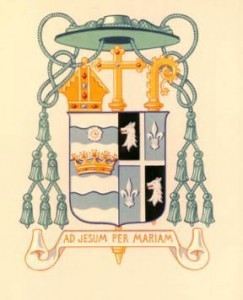 The entire “achievement,” or coat of arms as it is generally called, is composed of the shield with its charges, the motto and the external ornaments. As one looks at the shield the terms dexter (right) and sinister (left) must be understood contrariwise, as the shield was worn on the arm in medieval days and these terms were used in the relationship of the one bearing the shield.
The entire “achievement,” or coat of arms as it is generally called, is composed of the shield with its charges, the motto and the external ornaments. As one looks at the shield the terms dexter (right) and sinister (left) must be understood contrariwise, as the shield was worn on the arm in medieval days and these terms were used in the relationship of the one bearing the shield.
The dexter impalement is given in ecclesiastical heraldry to the arms of jurisdiction; in this instance, the arms of the Diocese of Atlanta.
Atlanta known as the “Crossroads of the South,” because of converging railroads which gave the city its early prominence, received its name as the eastern terminus of the Western and Atlantic Railroad which connected north Georgia with the Tennessee River. Originally called Whitehall, then Terminus, and afterwards in 1843 Marthasville, the state legislature finally acquiesced to the wishes of the railroad and accepted the name of Atlanta in 1847, thus naming the city indirectly after the Atlantic Ocean.
The Atlantic Ocean is represented on the shield of the diocese by white and blue wavy bars, the heraldic equivalent of the waves of the sea; seven bars in number to symbolize the Seven Sacraments.
The crown of Christ the King denotes the title of the cathedral church, the Eternal King whose redeeming Sacrifice on the Cross is renewed daily in the Holy Sacrifice of the Mass. Above the crown is placed the Cherokee rose, the State flower of Georgia (Rosa Laevigata), as befits a diocese located in the Capital City. The Cherokee rose is a white flower with a yellow center.
The crown of Christ the King, in the arms of the Diocese of Atlanta, also has the secondary representation of the crown of King George II of England after whom Georgia was named. The blue and white wavy bands may be said as well to symbolize the rolling foothills of the Blue Ridge country; but, more important, these are the colors of our Blessed Mother.
The sinister impalement, on the right of the viewer, bears the personal arms of Bishop Hyland.
The coat of arms is based on “faolan,” the Gaelic derivation of Hyland. “Faolan” is the diminutive of “faol” which means “wolf.” The name was common in the sixteenth century in Offaly and Leix, whence it spread into other parts of Ireland. Hyland is the usual form of the name in Leinster.
Consequently, a wolf’s head erased (torn) is placed in the pronominal or paternal quarters, the first and the fourth. In these quarters there is also a reference to “McCarron,” the maiden name of Bishop Hyland’s mother. McCarron is derived from the Gaelic root “Ciar” meaning black, and the bishop has so tinctured there quarters to commemorate his mother on his episcopal escutcheon.
The silver cross and the two fleurs-de-lis have been abstracted from the second and third quarters of the coat of arms of Saint Francis de Sales to honor Bishop Hyland’s baptismal patron. The fleurs-de-lis are golden on the arms of Saint Francis, but they have been changed to silver in order that the colors of the Blessed Virgin Mary, blue and white (silver) might be displayed and that this distinction might constitute a brisure to make these Hyland arms particularly those of the bishop.
The motto “Ad Jesum Per Mariam,” is translated “To Jesus through Mary.”
The external ornaments are composed of the green pontifical hat with its six like-tinctured tassels on each side disposed in three rows, the mitre, the processional cross and the crosier, the latter in gold.
Prior to 1870, the pontifical hat was worn in solemn conclaves held in conjunction with papal functions. The color of the pontifical hat and the number and color of the tassels were signs of the rank of a prelate, a custom which is still preserved in ecclesiastical heraldry.

